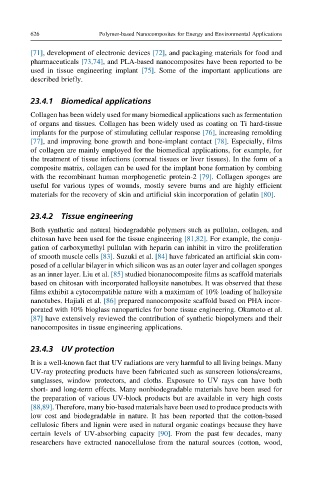Page 681 - Polymer-based Nanocomposites for Energy and Environmental Applications
P. 681
626 Polymer-based Nanocomposites for Energy and Environmental Applications
[71], development of electronic devices [72], and packaging materials for food and
pharmaceuticals [73,74], and PLA-based nanocomposites have been reported to be
used in tissue engineering implant [75]. Some of the important applications are
described briefly.
23.4.1 Biomedical applications
Collagen has been widely used for many biomedical applications such as fermentation
of organs and tissues. Collagen has been widely used as coating on Ti hard-tissue
implants for the purpose of stimulating cellular response [76], increasing remolding
[77], and improving bone growth and bone-implant contact [78]. Especially, films
of collagen are mainly employed for the biomedical applications, for example, for
the treatment of tissue infections (corneal tissues or liver tissues). In the form of a
composite matrix, collagen can be used for the implant bone formation by combing
with the recombinant human morphogenetic protein-2 [79]. Collagen sponges are
useful for various types of wounds, mostly severe burns and are highly efficient
materials for the recovery of skin and artificial skin incorporation of gelatin [80].
23.4.2 Tissue engineering
Both synthetic and natural biodegradable polymers such as pullulan, collagen, and
chitosan have been used for the tissue engineering [81,82]. For example, the conju-
gation of carboxymethyl pullulan with heparin can inhibit in vitro the proliferation
of smooth muscle cells [83]. Suzuki et al. [84] have fabricated an artificial skin com-
posed of a cellular bilayer in which silicon was as an outer layer and collagen sponges
as an inner layer. Liu et al. [85] studied bionanocomposite films as scaffold materials
based on chitosan with incorporated halloysite nanotubes. It was observed that these
films exhibit a cytocompatible nature with a maximum of 10% loading of halloysite
nanotubes. Hajiali et al. [86] prepared nanocomposite scaffold based on PHA incor-
porated with 10% bioglass nanoparticles for bone tissue engineering. Okamoto et al.
[87] have extensively reviewed the contribution of synthetic biopolymers and their
nanocomposites in tissue engineering applications.
23.4.3 UV protection
It is a well-known fact that UV radiations are very harmful to all living beings. Many
UV-ray protecting products have been fabricated such as sunscreen lotions/creams,
sunglasses, window protectors, and cloths. Exposure to UV rays can have both
short- and long-term effects. Many nonbiodegradable materials have been used for
the preparation of various UV-block products but are available in very high costs
[88,89]. Therefore, many bio-based materials have been used to produce products with
low cost and biodegradable in nature. It has been reported that the cotton-based
cellulosic fibers and lignin were used in natural organic coatings because they have
certain levels of UV-absorbing capacity [90]. From the past few decades, many
researchers have extracted nanocellulose from the natural sources (cotton, wood,

